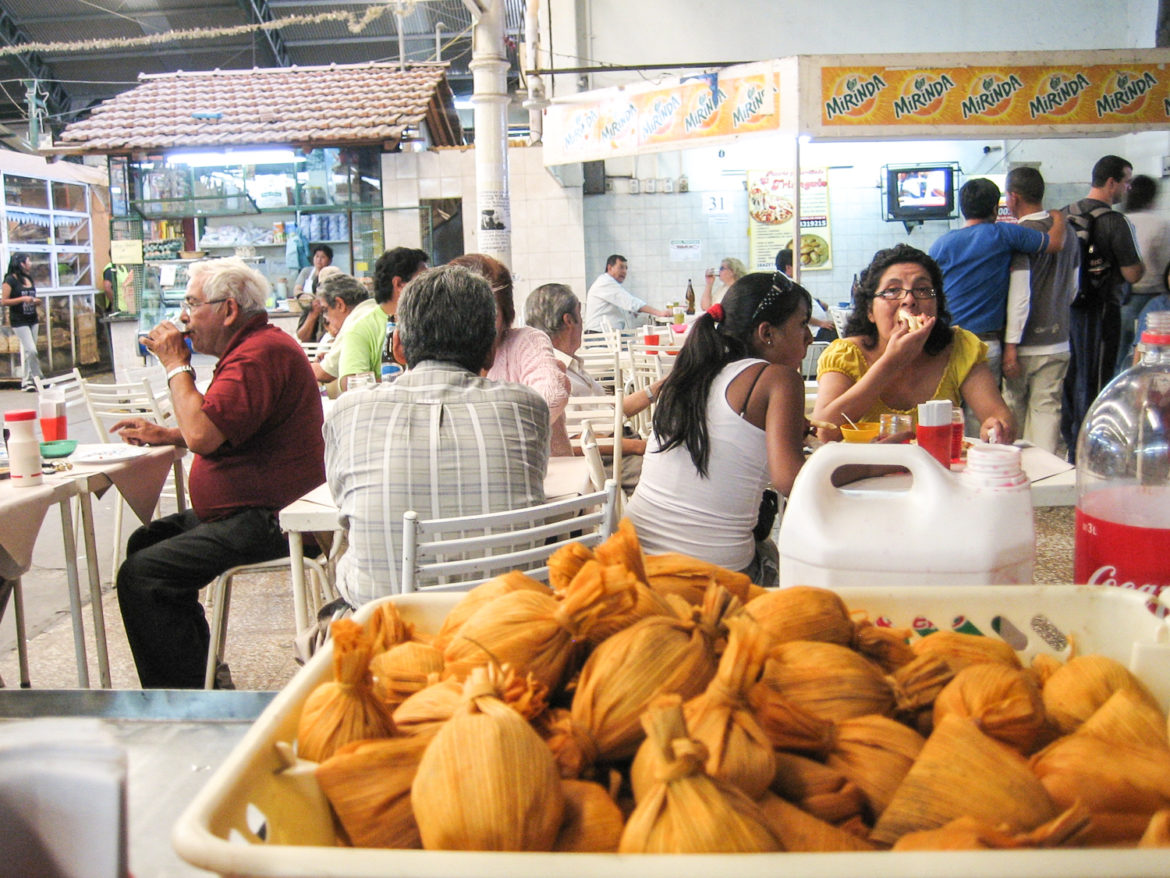Salta is an elegant colonial town with balmy weather, leafy plazas and an easygoing way of life.
Known as Salta la Linda (“Salta the beautiful”), it was also the ideal setting for us to regain our health. We had spent a grueling cross-country trip through the Uyuni Salt Flats and Atacama Desert. Ill from accidentally eating spoiled llama meat, we both had varying degrees of food poisoning. Somehow we made it through a long wait at the Bolivia-Argentina border. Then we endured a two-hour bus ride to the mountain town of Huamahuaca where we spent the night. The next day, still recovering, we made the three-hour bus ride to Salta. From the window, we watched as the cold, high desert of the Andean plateau transformed into a lush, tree-lined landscape. The warm, fresh air already made a big difference in how we were feeling.
After settling into a private apartment, we stumbled on Meeting Café. For the first time in weeks, we enjoyed a freshly brewed cup of coffee, along with delicious homemade pastries. While our Altiplano adventures and jungle trekking in The Amazon had been amazing, it was nice to be back in civilization.
Life is good in Salta. A thriving cafe culture. Delicious cuisine. And wonderful local traditions.
People are very friendly. When we walked into local eatery, La Tacita, a group of old men insisted we watch a soccer game on TV with them. We pulled up a couple of chairs and practiced our rudimentary Spanish over some of the city’s best empanadas. Later that week, we actually had the opportunity to attend a traditional futbol game. At the local stadium, Club de Gimnasia Y Tiro, we joined passionate Salta fans to cheer against their rival, Tucuman. Despite being lower ranking teams, the passion of the attendees was palpable. Non-stop chanting, yelling, jumping. Police security was at an all-time high. Some officers were on horseback and many carried guns — their visible presence to help maintain crowd control. Apparently, alcohol isn’t even sold at the games to dissuade any craziness.
Salta is full of beautiful architectural sights. Among the Spanish colonial buildings, the Neoclassical Cathedral of Salta and the crimson red Church of St. Francis add to the town’s vibrant personality. Public spaces like the 16th-century Plaza 9 de Julio, named after Argentina’s independence day, are perfect for relaxing and watching the world go by. Under a statue of José de San Martin (Argentina’s national hero), we also enjoyed a couple of picnics here including baked empanadas from nearby Doña Salta.
Aside from empanadas, Salta’s other culinary claim-to-fame is its mouth-watering steak.
On our first evening in Salta, we enjoyed a spectacular meal at El Viejo Jack. Sitting outside on a beautiful evening, we shared a massive Bife de Chorizo (Sirloin Strip). It came with mashed potatoes and a bottle of classic vino tinto (red wine), all for less than $25. We couldn’t even finish the steak, it was so huge.
But it’s not necessary to go to a steakhouse or fancy restaurant to enjoy good food. At the Mercado San Miguel, we joined locals for homemade tamales at the most authentic lunch spot in town. Salteños also take part in merienda, a daily tradition of afternoon coffee and cake (or cookies). We often opted for ice cream from one of the many heladerias around town. Suffice it to say, it’s difficult to go hungry in Salta.
Thankfully, we were able to work off all the food we ate by walking a lot. One morning, we took the Salta Tram (Teleferico) to the top of San Bernardo Hill, offering a beautiful view of the Lerma Valley and the surrounding mountains. Afterwards, we made the hour-long hike down, taking in the scenery and soaking up the warm sunshine. Renting a car, we also drove out to the suburb of San Lorenzo to visit the charming hotel, El Castillo. We strolled the nearby nature reserve, then split a Salta beer on the outdoor patio. A great way to spend the afternoon.
One of the most memorable experiences of our Salta visit was partaking in a local peña.
A peña is a social gathering that typically involves traditional food, live music and dancing. It reflects the history of Salta, as well as the Andean culture and is popular with both locals and tourists. Our last evening in Salta, we made the hour-long walk from our guesthouse to La Casona del Molino (“The Mill House.”) Sitting on the outdoor patio of this former mansion watching locals play guitar and sing folk songs was like stepping back in time. To ensure a table, we arrived around 9pm, early by Salteño standards. While enjoying an aside de tire (short rib) and hearty mixed salad, we watched families, many with young children, continue to show up well after 11pm.
With the hiss of steak cooking over a charcoal grill, we sat back and took in the scene. With content bellies and a low-key wine buzz, we watched as impromptu performances unfolded before us. What more could you ask for… a wonderful meal, uplifting music and a sense of belonging. What a gorgeous evening in Salta la Linda.

